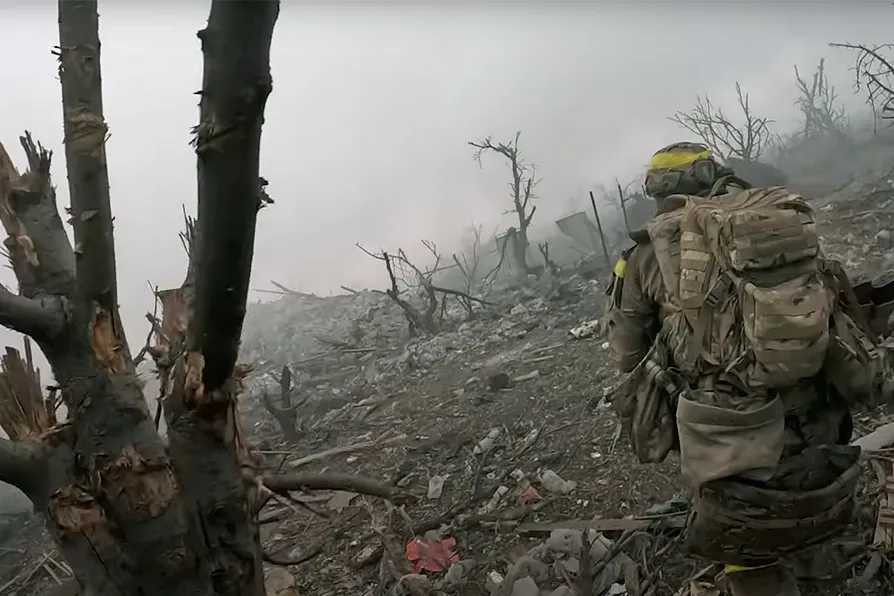MARIA DUARTE picks the best and worst of a crowded year of films
ED RAMPELL is disappointed by the confusing results of embedding cameras amid a Ukranian platoon

 A still from 2000 Meters to Andriivka [Pic: IMDb]
A still from 2000 Meters to Andriivka [Pic: IMDb]
ALTHOUGH I’ve reported on many anti-war protests, the closest I’ve ever come to covering combat was reporting on war games in Hawaii for Radio Australia. I was even catapulted in a jet from an aircraft carrier. But as a peace advocate who has always opposed war, I never wanted to see warfare up close and personal.
Ukrainian combat correspondent/photojournalist/documentarian Mstyslav Andriiovych Chernov, on the other hand, has covered many war and conflict zones and, among his myriad of accolades, won a Pulitzer Prize, as well as a Best Documentary Oscar for his 2023 nonfiction film 20 Days in Mariupol, about journalists covering the siege of that Ukrainian city.
Now the intrepid Kharkiv-born, 40-year-old Chernov is back with another documentary about the war still devastating his native land. 2000 Meters to Andriivka, which scored a Sundance Film Festival documentary award, is a sort of follow up to 20 Days in Mariupol.
It tells the story of a Ukrainian platoon which, over a period of months in 2023, made its way through a narrow swathe of forest that is flanked on both sides by minefields. At the apex of the woods is the eponymous village of Andriivka. Chernov was embedded with the Ukrainian warriors for at least part of the period covered.
2000 Meters to Andriivka provides a platoon’s-eye view of the campaign to liberate the Ukrainian hamlet. To do so, GoPro cameras were mounted on the infantrymen’s helmets, and about half of the documentary’s footage is composed of this bodycam video. While it’s true that this technique bestows a “you-are-there” sensibility upon the material, much of what was culled from 100-hours of shooting by California-born editor Michelle Mizner (who also cut 20 Days in Mariupol) for the 107-minute 2000 Meters is in the form of close-ups and extreme close-ups. The effect is meant to render fly-on-the-wall verisimilitude coverage of combat, shot by those who actually fought (and in some cases, died).
But unfortunately, in reality, 2000 Meters to Andriivka frequently struck me as disjointed. Shots were strung together supposedly in chronological order, but we just have to take their word for it that they are not playing fast and loose in the editing process.
The constant close-ups were disorienting and there were some extreme close-ups that I simply couldn’t make head or tail of, even though they were held onscreen for seconds. I had no idea what I was watching or why this image was onscreen. Sam Slater’s original ominous soundtrack, however, is on point.
To be fair, in addition to the bodycam video shot by the soldiers, there is also drone footage (about 50 hours-worth was shot for this film which the director said had a $400,000 budget) which provides an aerial, spatial perspective upon the onscreen action. Nevertheless, if during the US Civil War, General William Tecumseh Sherman said “War is hell,” one could say that based upon 2000 Meters’ visual record of battles in Ukraine that “War is dull.”
This film periodically has onscreen titles informing viewers how many metres the Ukrainian fighters are from Andriivka, and the impression I had was that this painstakingly fought military campaign was “the big slog.” It looked similar to the trench warfare from World War I, which D.W. Griffith risked his neck to shoot at the front lines in his 1918 Hearts of the World propaganda picture starring Lillian and Dorothy Gish.
Some viewers might feel that the documentary imparts a strong sense of the futility of war. But is fighting back against an army invading one’s country “futile”? Or is it heroic? Having said that, Chernov’s film is completely one-sided, the Russians are rarely seen and their point of view is never presented.
Was the US lying to President Mikhail Gorbachev in the last days of the Soviet Union about Nato expansion to the east, to the point where the military alliance created to contain and thwart the USSR is now right at the doorstep of Russia, justified? Not that this, in turn, justifies Putin’s homicidal overreaction, but it does help to explain it. However, you’d never know it from watching this flag waving (literally) unabashedly pro-Ukraine film.
As this horrific invasion grinds on and as someone descended from Ukrainians from Kiev and Odessa, I wish that I could be more enthusiastic about the second documentary by Chenov. Alas, to be honest, Chernov’s film was pretty boring, repetitive, and at times hard to decipher. But it did succeed in impressing upon me once again the horrors of war and the hope that Putin’s punishing blitz will come to a halt ASAP.
2000 Meters to Andriivka is in cinemas now

MARIA DUARTE cherishes the flashes of absurd humour and theme of community healing in a documentary set in a Soviet-era Black Sea sanatorium

As Britain marks 80 years since defeating fascism, it finds itself in a proxy war against Russia over Ukraine — DANIEL POWELL examines Churchill’s secret plan to attack our Soviet allies in 1945 and traces how Nato expansion, a Western-backed coup and neo-nazi activism contributed to todays' devastating conflict












